Berg J.M., Tymoczko J.L., Stryer L. Biochemistry
Подождите немного. Документ загружается.

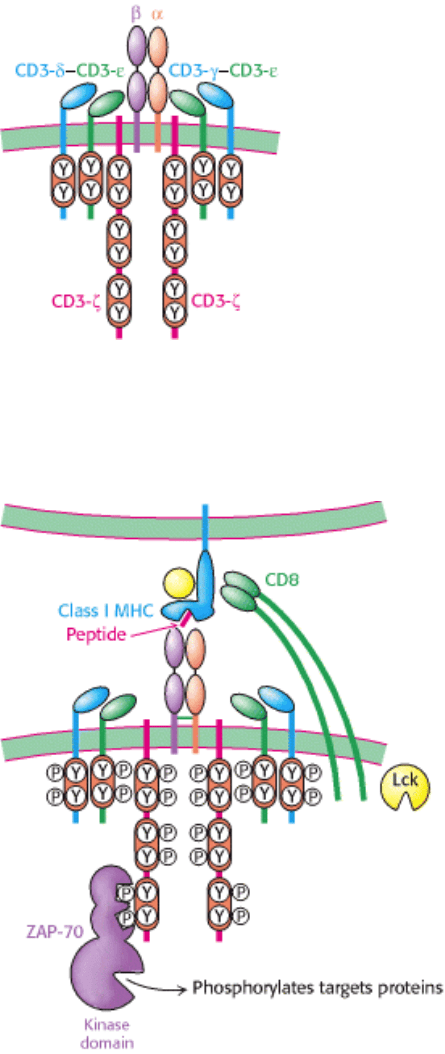
IV. Responding to Environmental Changes 33. The Immune System 33.5. Major-Histocompatibility-Complex Proteins Present Peptide Antigens on Cell Surfaces for Recognition by T-Cell Receptors
Figure 33.29. T-Cell Receptor Complex. The T-cell receptor is associated with six CD3 molecules: a CD3-γ - CD3-ε
heterodimer, a CD3-δ - CD3-ε heterodimer, and two chains of CD3-ζ. Single ITAM sequences are present in the
cytoplasmic domains of CD3-γ, CD3-δ, and CD3-ε whereas three such sequences are found in each CD3-ζ chain.
IV. Responding to Environmental Changes 33. The Immune System 33.5. Major-Histocompatibility-Complex Proteins Present Peptide Antigens on Cell Surfaces for Recognition by T-Cell Receptors
Figure 33.30. T-Cell Activation. The interaction between the T-cell receptor and a class I MHC-peptide complex results
in the binding of CD8 to the MHC protein, the recruitment of the protein tyrosine kinase Lck, and the phosphorylation of
tyrosine residues in the ITAM sequences of the CD3 chains. After phosphorylation, the ITAM regions serve as docking
sites for the protein kinase ZAP-70, which phosphorylates protein targets to transmit the signal.
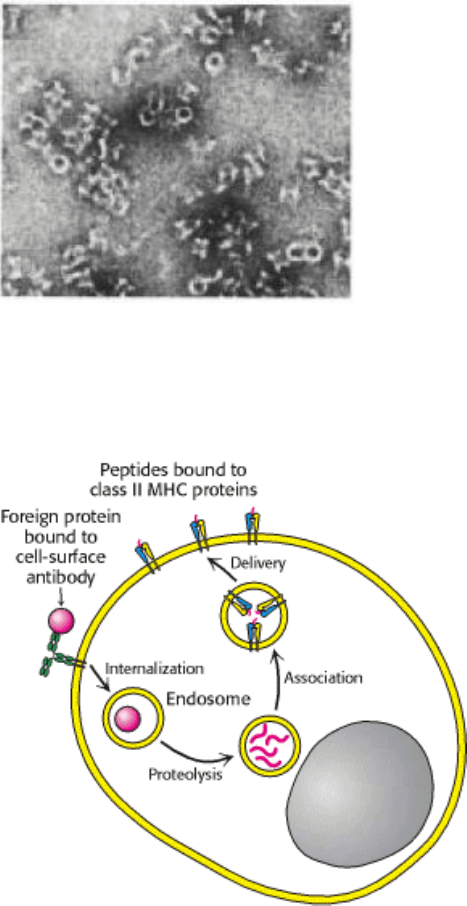
IV. Responding to Environmental Changes 33. The Immune System 33.5. Major-Histocompatibility-Complex Proteins Present Peptide Antigens on Cell Surfaces for Recognition by T-Cell Receptors
Figure 33.31. Consequences of Cytotoxic-T-Cell Action. An electron micrograph showing pores in the membrane of a
cell that has been attacked by a cytotoxic T cell. The pores are formed by the polymerization of perforin, a protein
secreted by the cytotoxic T cell. [Courtesy of Dr. Eckhard Podock.]
IV. Responding to Environmental Changes 33. The Immune System 33.5. Major-Histocompatibility-Complex Proteins Present Peptide Antigens on Cell Surfaces for Recognition by T-Cell Receptors
Figure 33.32. Presentation of Peptides from Internalized Proteins. Antigen-presenting cells bind and internalize
foreign proteins and display peptides that are formed from the digestion of these proteins in Class II MHC proteins.
IV. Responding to Environmental Changes 33. The Immune System 33.5. Major-Histocompatibility-Complex Proteins Present Peptide Antigens on Cell Surfaces for Recognition by T-Cell Receptors
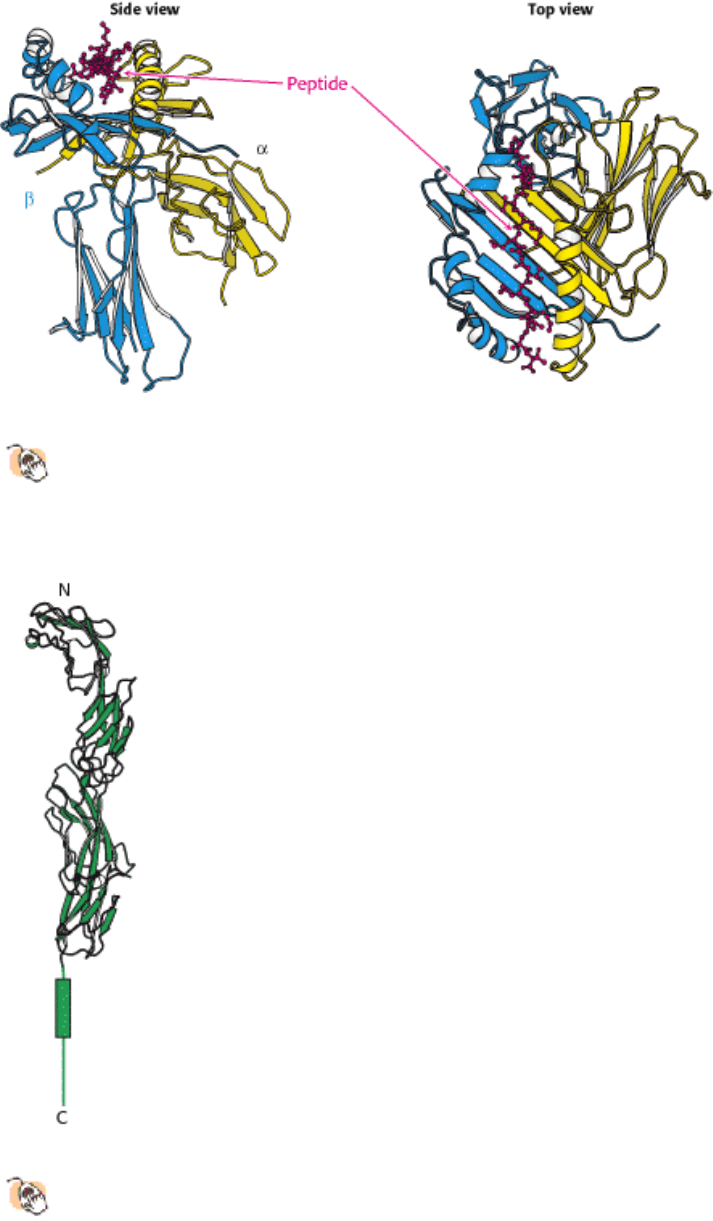
Figure 33.33. Class II MHC Protein.
A class II MHC protein consists of homologous α and β chains, each of which
has an amino-terminal domain that constitutes half of the peptide-binding structure, as well as a carboxyl-terminal
immunoglobulin domain. The peptide-binding site is similar to that in class I MHC proteins except that it is open
at both ends, allowing class II MHC proteins to bind longer peptides than those bound by class I.
IV. Responding to Environmental Changes 33. The Immune System 33.5. Major-Histocompatibility-Complex Proteins Present Peptide Antigens on Cell Surfaces for Recognition by T-Cell Receptors
Figure 33.34. Coreceptor CD4.
This protein comprises four tandem immunoglobulin domains that extend from the
surface of helper T cells.
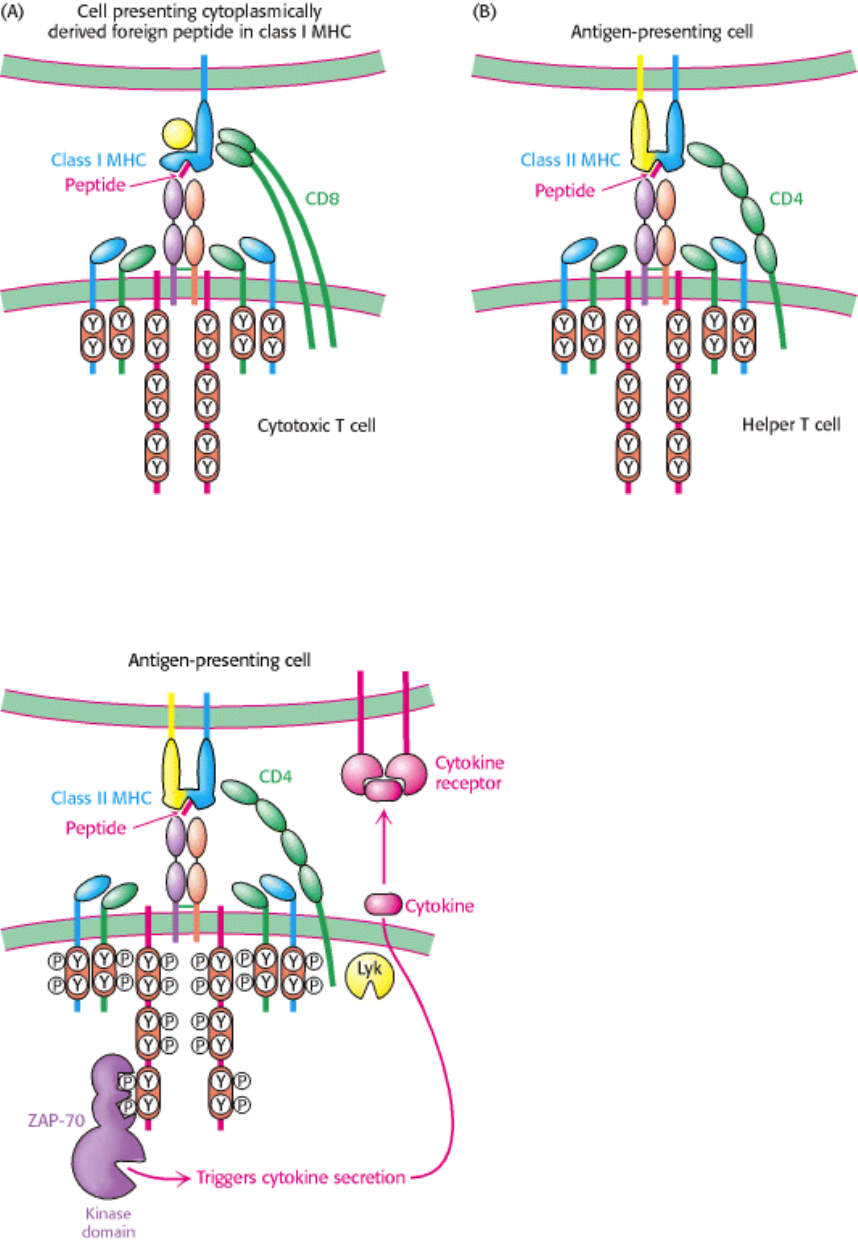
IV. Responding to Environmental Changes 33. The Immune System 33.5. Major-Histocompatibility-Complex Proteins Present Peptide Antigens on Cell Surfaces for Recognition by T-Cell Receptors
Figure 33.35. Variations on a Theme. (A) Cytotoxic T cells recognize foreign peptides presented in class I MHC
proteins with the aid of the coreceptor CD8. (B) Helper T cells recognize peptides presented in class II MHC proteins by
specialized antigen-presenting cells with the aid of the coreceptor CD4.
IV. Responding to Environmental Changes 33. The Immune System 33.5. Major-Histocompatibility-Complex Proteins Present Peptide Antigens on Cell Surfaces for Recognition by T-Cell Receptors
Figure 33.36. Helper T Cell Action. The engagement of the T-cell receptor in helper T cells results in the secretion of
cytokines. These cytokines bind to cytokine receptors expressed on the surface of the antigen-presenting cell, stimulating
cell growth, differentiation, and, in regard to a B cell, antibody secretion.

IV. Responding to Environmental Changes 33. The Immune System 33.5. Major-Histocompatibility-Complex Proteins Present Peptide Antigens on Cell Surfaces for Recognition by T-Cell Receptors
Figure 33.37. Polymorphism in Class I MHC Protein.
The positions of sites with a high degree of polymorphism in
the human population are displayed as red spheres on the structure of the amino-terminal part of a class I MHC
protein.
IV. Responding to Environmental Changes 33. The Immune System 33.5. Major-Histocompatibility-Complex Proteins Present Peptide Antigens on Cell Surfaces for Recognition by T-Cell Receptors
Figure 33.38. Human Immunodeficiency Virus. A schematic diagram of HIV reveals its proteins and nucleic acid
components. The membrane-envelope glycoproteins gp41 and gp120 are shown in dark and light green. The viral RNA
is shown in red, and molecules of reverse transcriptase are shown in blue. [After R. C. Gallo. The AIDS virus. Copyright
© 1987 by Scientific American, Inc. All rights reserved.]
IV. Responding to Environmental Changes 33. The Immune System 33.5. Major-Histocompatibility-Complex Proteins Present Peptide Antigens on Cell Surfaces for Recognition by T-Cell Receptors
Figure 33.39. HIV Receptor. A complex between a modified form of the envelope glycoprotein gp120 from HIV and a

peptide corresponding to the two amino-terminal domains from the helper T-cell protein CD4 reveals how viral
infection of helper T cells is initiated.
IV. Responding to Environmental Changes 33. The Immune System
33.6. Immune Responses Against Self-Antigens Are Suppressed
The primary function of the immune system is to protect the host from invasion by foreign organisms. But how does the
immune system avoid mounting attacks against the host organism? In other words, how does the immune system
distinguish between self and nonself? Clearly, proteins from the organism itself do not bear some special tag identifying
them. Instead, selection processes early in the developmental pathways for immune cells kill or suppress those immune
cells that react strongly with self-antigens. The evolutionary paradigm still applies; immune cells that recognize self-
antigens are generated, but selective mechanisms eliminate such cells in the course of development.
33.6.1. T Cells Are Subject to Positive and Negative Selection in the Thymus
T cells derive their name from the location of their production
the thymus, a small organ situated just above the heart.
Examination of the developmental pathways leading to the production of mature cytotoxic and helper T cells reveals the
selection mechanisms that are crucial for distinguishing self from nonself. These selection criteria are quite stringent;
approximately 98% of the thymocytes, the precursors of T cells, die before the completion of the maturation process.
Thymocytes produced in the bone marrow do not express the T-cellreceptor complex, CD4, or CD8. On relocation to the
thymus and rearrangement of the T-cell-receptor genes, the immature thymocyte expresses all of these molecules. These
cells are first subjected to positive selection (Figure 33.40). Cells for which the T-cell receptor can bind with reasonable
affinity to either class I or class II MHC molecules survive this selection; those for which the T-cell receptor does not
participate in such an interaction undergo apoptosis and die. The affinities of interaction required to pass this selection
are relatively modest, and so contacts between the T-cell receptor and the MHC molecules themselves are sufficient
without any significant contribution from the bound peptides (which will be derived from proteins in the thymus). The
role of the positive selection step is to prevent the production of T cells that will not bind to any MHC complex present,
regardless of the peptide bound.
The cell population that survives positive selection is subjected to a second step, negative selection. Here, T cells that
bind with high affinity to MHC complexes bound to self-peptides expressed on the surfaces of antigen-presenting cells in
the thymus undergo apoptosis or are otherwise suppressed. Those that do not bind too avidly to any such MHC complex
complete development and become mature cytotoxic T cells (which express only CD8) or helper T cells (which express
only CD4). The negative selection step leads to self tolerance; cells that bind an MHC-self-peptide complex are removed
from the T-cell population. Similar mechanisms apply to developing B cells, suppressing B cells that express antibodies
that interact strongly with self-antigens.
33.6.2. Autoimmune Diseases Result from the Generation of Immune Responses
Against Self-Antigens
Although thymic selection is remarkably efficient in suppressing the immune response to self-antigens, failures do
occur. Such failures results in autoimmune diseases. These diseases include relatively common illnesses such as
insulin-dependent diabetes mellitus, multiple sclerosis, and rheumatoid arthritis. In these illnesses, immune responses
against self-antigens result in damage to selective tissues that express the antigen (Figure 33.41).
In many cases, the cause of the generation of self-reactive antibodies or T cells in unclear. However, in other cases,
infectious organisms such as bacteria or viruses may play a role. Infection leads to the generation of antibodies and T
cells that react with many different epitopes from the infectious organism. If one of these antigens closely resembles a
self-antigen, an autoimmune response can result. For example, Streptococcus infections sometimes lead to rheumatic
fever owing to the production of antibodies to streptococcal antigens that cross-react with exposed molecules in heart
muscle.
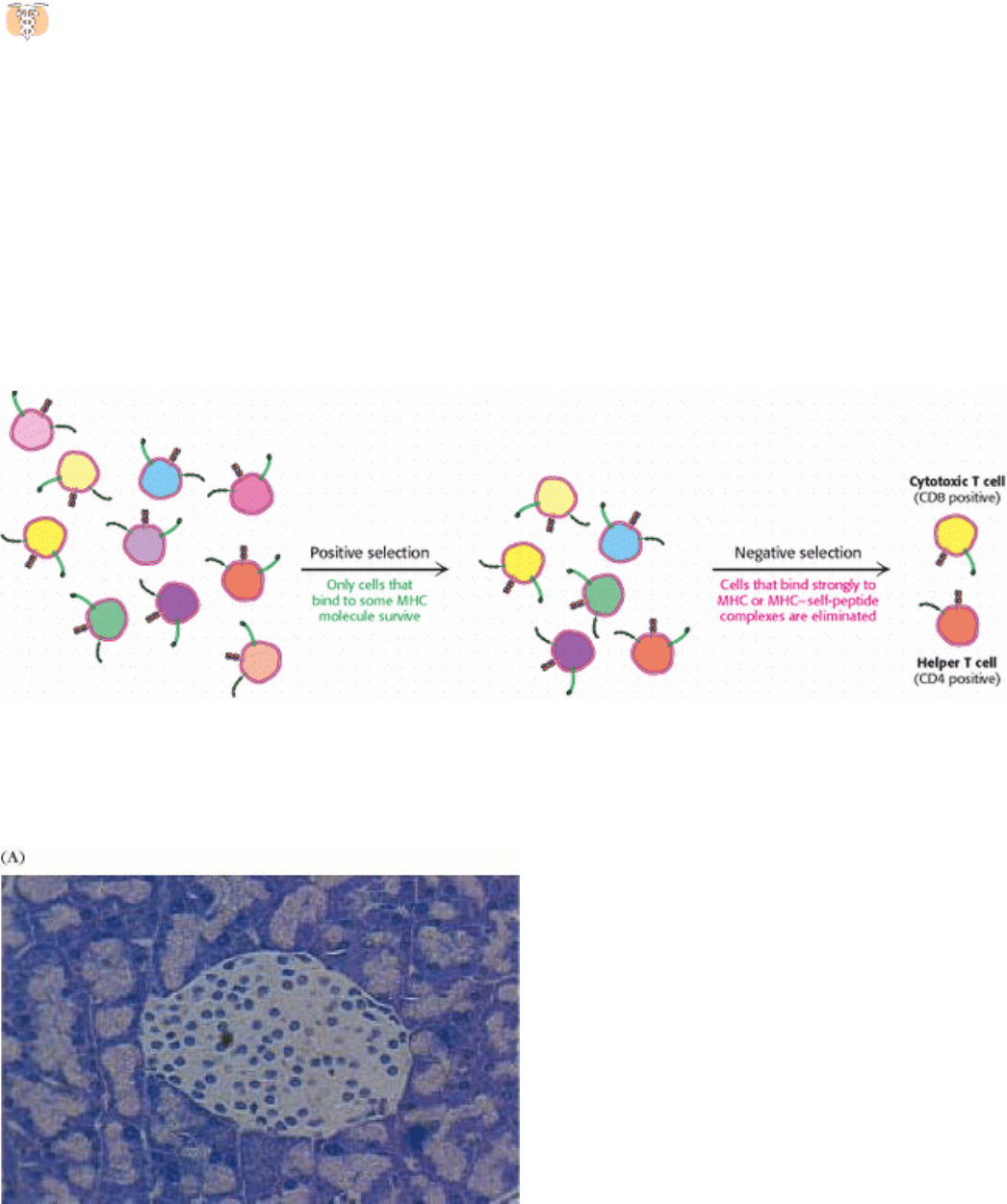
33.6.3. The Immune System Plays a Role in Cancer Prevention
The development of immune responses against proteins encoded by our own genomes can be beneficial under
some circumstances. Cancer cells have undergone significant changes that often result in the expression of
proteins that are not normally expressed. For example, the mutation of genes can generate proteins that do not
correspond in amino acid sequence to any normal protein. Such proteins may be recognized as foreign, and an immune
response will be generated specifically against the cancer cell. Alternatively, cancer cells often produce proteins that are
expressed during embryonic development but are not expressed or are expressed at very low levels after birth. For
example, a membrane glycoprotein protein called carcinoembryonic antigen (CEA) appears in the gasterointestinal cells
of developing fetuses but is not normally expressed at significant levels after birth. More than 50% of patients with
colorectal cancer have elevated serum levels of CEA. Immune cells recognizing epitopes from such proteins will not be
subject to negative selection and, hence, will be present in the adult immune repertoire. These cells may play a cancer
surveillance role, killing cells that overexpress antigens such as CEA and preventing genetically damaged cells from
developing into tumors.
IV. Responding to Environmental Changes 33. The Immune System 33.6. Immune Responses Against Self-Antigens Are Suppressed
Figure 33.40. T-Cell Selection. A population of thymocytes is subjected first to positive selection to remove cells that
express T-cell receptors that will not bind to MHC proteins expressed by the individual organism. The surviving cells are
then subjected to negative selection to remove cells that bind strongly to MHC complexes bound to self-peptides.
IV. Responding to Environmental Changes 33. The Immune System 33.6. Immune Responses Against Self-Antigens Are Suppressed
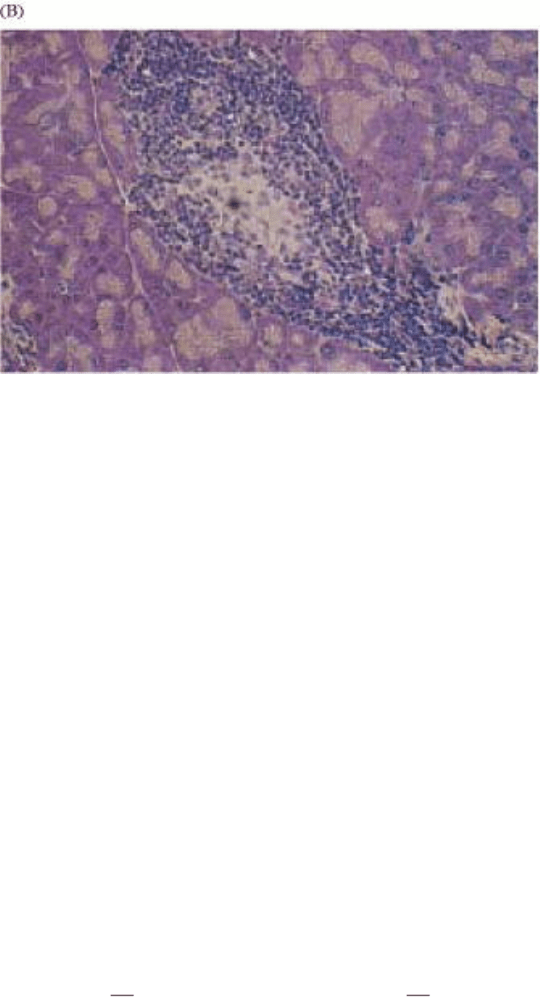
Figure 33.41. Consequences of Autoimmunity. Photo-micrographs of an islet of Langerhans (A) in the pancreas of a
normal mouse and (B) in the pancreas of a mouse with an immune response against pancreatic β cells, which results in a
disease resembling insulin-dependent diabetes mellitus in human beings. [From M. A. Atkinson and N. K. Maclaren.
What causes diabetes? Copyright © 1990 by Scientific American, Inc. All rights reserved.]
IV. Responding to Environmental Changes 33. The Immune System
Summary
To respond effectively to a vast array of pathogens, the immune system must be tremendously adaptable. Adaptation by
the immune system follows the principles of evolution: an enormously diverse set of potentially useful proteins is
generated; these proteins are then subjected to intense selection so that only cells that express useful proteins flourish and
continue development, until an effective immune response to a specific invader is generated.
Antibodies Possess Distinct Antigen-Binding and Effector Units
The major immunoglobulin in the serum is immunoglobulin G. An IgG protein is a heterotetramer with two heavy chains
and two light chains. Treatment of IgG molecules with proteases such as papain produces three fragments: two F
ab
fragments that retain antigen-binding activity and an F
c
fragment that retains the ability to activate effector functions
such as the initiation of the complement cascade. The F
ab
fragments include the L chain and the amino-terminal half of
the H chain; the F
c
domain is a dimer consisting of the carboxyyl-terminal halves of two H chains. Five different classes
of antibody
IgG, IgM, IgA, IgD, and IgE differ in their heavy chains and, hence, in their effector functions.
The Immunoglobulin Fold Consists of a Beta-Sandwich Framework with
Hypervariable Loops
One particular protein fold is found in many of the key proteins of the immune system. The immunoglobulin fold
consists of a pair of β sheets that pack against one another, linked by a single disulfide bond. Loops projecting from one
end of the structure form a binding surface that can be varied by changing the amino acid sequences within the loops.
Domains with immunoglobulin folds are linked to form antibodies and other classes of proteins in the immune system
including T-cell receptors.
Antibodies Bind Specific Molecules Through Their Hypervariable Loops
Two chains come together to form the binding surface of an antibody. Three loops from each domain, the
complementarity-determining regions, form an essentially continuous surface that can vary tremendously in shape,
charge, and other characteristics to allow particular antibodies to bind to molecules ranging from small molecules to
large protein surfaces.
Diversity Is Generated by Gene Rearrangements
The tremendous diversity of the amino acid sequences of antibodies is generated by segmental rearrangements of genes.
For antibody κ light chains, one of 40 variable regions is linked to one of five joining regions. The combined VJ unit is
then linked to the constant region. Thousands of different genes can be generated in this manner. Similar arrays are
rearranged to form the genes for the heavy chains, but an additional region called the diversity region lies between the V
and the J regions. The combination L and H chains, each obtained through such rearranged genes, can produce more than
10
8
distinct antibodies. Different classes of antibodies are also generated by gene rearrangements that lead to class
switching. Oligomerization of membrane-bound antibody molecules initiates a signal-transduction cascade inside B
cells. Key steps in this signaling process include the phosphorylation of specific tyrosine residues in sequences termed
immunoreceptor tyrosine-based activation motifs (ITAMs), present in proteins that associate with the membrane-bound
antibodies.
Major-Histocompatibility-Complex Proteins Present Peptide Antigens on Cell Surfaces
for Recognition by T-Cell Receptors
Intracellular pathogens such as viruses and mycobacteria cannot be easily detected. Intracellular proteins are constantly
being cut into small peptides by proteasomes and displayed in class I major-histocompatibility-complex proteins on cell
surfaces. Such peptides lie in a groove defined by two helices in the class I MHC proteins. The combination of MHC
protein and peptide can be bound by an appropriate T-cell receptor. T-cell receptors resemble the antigen-binding
domains of antibodies in structure, and diversity in T-cell-receptor sequence is generated by V(D)J gene rearrangements.
The T-cell receptor recognizes features of both the peptide and the MHC molecule that presents it. Cytotoxic T cells
initiate apoptosis in cells to which they bind through T-cell receptor-class I MHC-peptide interactions aided by
interactions with the coreceptor molecule CD8. Helper T cells recognize peptides presented in class II MHC proteins, a
distinct type of MHC protein expressed only on antigen-presenting cells such as B cells and macrophages. Helper T cells
express the coreceptor CD4, rather than CD8. CD4 interacts with class II MHC proteins present on antigen-presenting
cells. Signaling pathways, analogous to those in B cells, are initiated by interactions between MHC-peptide complexes
and T-cell receptors and the CD8 and CD4 coreceptors. Human immunodeficiency virus damages the immune system by
infecting cells that express CD4, such as helper T cells.
Immune Responses Against Self-Antigens Are Suppressed
In principle, the immune system is capable of generating antibodies and T-cell receptors that bind to self-molecules; that
is, molecules that are normally present in a healthy and uninfected individual organism. Selection mechanisms prevent
such self-directed molecules from being expressed at high levels. The selection process includes both positive selection,
to enrich the population of cells that express molecules that have the potential to bind foreign antigens in an appropriate
context, and negative selection, which eliminates cells that express molecules with too high an affinity for self-antigens.
Autoimmune diseases such as insulin-dependent diabetes mellitus can result from amplification of a response against a
self-antigen.
Key Terms
humoral immune response
B lymphocyte (B cell)
antigen
antigenic determinant (epitope)
cellular immune response
cytotoxic T lymphocyte (killer T cell)
helper T lymphocyte
immunoglobulin G
F
ab
F
c
light chain
heavy chain
segmental flexibility
immunoglobulin M
immunoglobulin A
immunoglobulin D
immunoglobulin E
variable region
constant region
immunoglobulin fold
hypervariable loop
complementarity-determining region (CDR)
V(D)J recombination
immunoreceptor tyrosine-based activation motif (ITAM)
cyclosporin
hapten
class switching
T cell
major histocompatibility complex (MHC)
